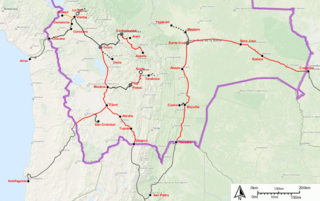This article describes the transport in Peru.

The Ferrocarril Chihuahua al Pacífico, also known as El Chepe from its reporting mark CHP, is a major rail line in northwest Mexico, linking Chihuahua City to Los Mochis and its port, Topolobampo. It crosses the Sierra Madre Occidental, part of the range that in the United States is called the Rocky Mountains. There is no road covering the trajectory.

Ferromex is a private rail consortium that operates the largest railway in Mexico with combined mileage of 12,100 kilometres (7,500 mi) and is part of the North American Class I railroads.

Empresa de los Ferrocarriles del Estado is the national railway and the oldest state-run enterprise in Chile. It manages the infrastructure and operating rail services in the country.

The Tren Suburbano is an electric suburban rail system in Mexico City. It is operated by Ferrocarriles Suburbanos with concessioned trains from Construcciones y Auxiliar de Ferrocarriles (CAF). It was designed to complement the extensive Mexico City metro system, Latin America's largest and busiest urban rail network.

Mexico has a freight railway system owned by the national government and operated by various entities under concessions (charters) granted by the national government. The railway system provides freight and passenger service throughout the country, connecting major industrial centers with ports and with rail connections at the United States border. Passenger rail services were limited to a number of tourist trains between 1997, when Ferrocarriles Nacionales de México suspended service, and 2008, when Ferrocarril Suburbano de la Zona Metropolitana de México inaugurated Mexico's first commuter rail service between Mexico City and the State of Mexico. This is not including the Mexico City Metro, which started service in 1969.

Ferrocarriles Nacionales de México was Mexico's state owned railroad company from 1938 to 1998, and prior to 1938, a major railroad controlled by the government that linked Mexico City to the major cities of Ciudad Juárez, Nuevo Laredo and Matamoros on the U.S. border. The first trains to Nuevo Laredo from Mexico City began operating in 1903.

The Ferrocarril del Pacífico is a former railroad line of Mexico that operated from Nogales, Sonora to Guadalajara, Jalisco via Mazatlán, Sinaloa.
The Ferrocarril Sonora–Baja California is a former railroad line of Mexico that built the line from Mexicali, Baja California, to Benjamín Hill, Sonora in 1948. It interchanged with the Southern Pacific Railroad at Calexico, California, and with the Ferrocarril del Pacifico in Benjamin Hill, Sonora. Before 1960, The SP-controlled Inter-California railroad provided trackage rights for the SBC from Pascualitos to the International Border. SBC took control of that part after the demise of the Inter-Cal.

As of 2022, no trains are operated in El Salvador. The national railroad corporation is FENADESAL, a division of CEPA. It oversees 554.8 km of all disused 3 ft narrow gauge lines connecting major cities and formerly linked with Guatemala railroads at Anguiatú.

Rail transport in Costa Rica is primarily under the stewardship of Incofer, an autonomous institution of the state. Incofer owns the national railway infrastructure and operates virtually all freight and passenger services, which consist primarily of commuter trains through the highly populated Central Valley. The whole Incofer network is 1,067 mm narrow gauge, although there are several small tourist railways of other gauges.
Cazadero and San Pablo Railroad was a 60-kilometer (37 mi), 2 ft narrow gauge line built in 1896 as the Ferrocarril Cazadero La Torre y Tepetongo from an interchange with the Mexican Central Railroad at Cazadero La Torre southwest through Nado to the sawmill community of San Pablo in Estado de México.

The Argentine railway network consisted of a 47,000 km (29,204 mi) network at the end of the Second World War and was, in its time, one of the most extensive and prosperous in the world. However, with the increase in highway construction, there followed a sharp decline in railway profitability, leading to the break-up in 1993 of Ferrocarriles Argentinos (FA), the state railroad corporation. During the period following privatisation, private and provincial railway companies were created and resurrected some of the major passenger routes that FA once operated.

The Bolivian rail network has had a peculiar development throughout its history.

The Mexican International Railroad was one of the primary pre-nationalization railways of Mexico. Incorporated in Connecticut in 1882 in the interests of the Southern Pacific Railroad (SP), it opened a main line from Piedras Negras to Torreón, on the Mexican Central Railway, in 1888, and to Durango in October 1892. Branches extended from Durango to Santa Catarina de Tepehuanes and Reata to Monterrey.

Buenos Aires al Pacífico S. A. was an Argentine company that exploited the operation and infrastructure of the 1,676 mm San Martín Railway freight rail transport system.

Lechería is a commuter railway station serving the Ferrocarril Suburbano, a suburban rail that connects the State of Mexico with Mexico City. The station is located in the municipality of Tultitlán, State of Mexico, north of Mexico City.

Buenavista Station, also called Buenavista Terminal, was a passenger train station in Mexico City. The station opened in 1873 and since 1909, the station was fully operated by Ferrocarriles Nacionales de México. The station was closed in 2005. By June 2008, the station was replaced by the terminus of the Tren Suburbano commuter rail service.

















